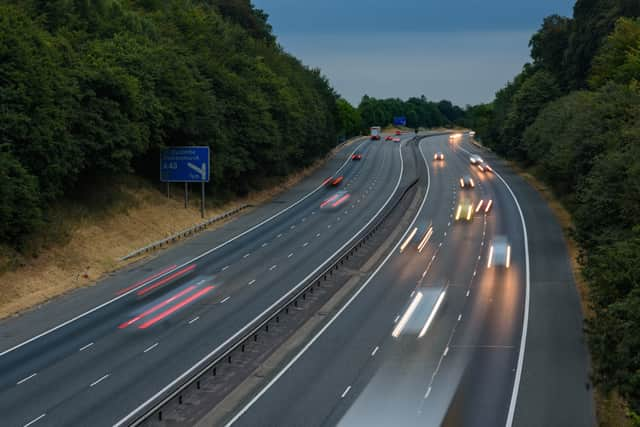What to do if you break down on a smart motorway: advice if your car fails on an all-lane running road


Smart motorways are making headlines again as the Tory party leadership candidates say they will stop the roll-out of the roads.
Public concerns around the safety of the roads have prompted Liz Truss and Rishi Sunak to suggest they could scrap them and earlier this year the Government paused the creation of any new stretches of all-lane running motorways.
Advertisement
Hide AdAdvertisement
Hide AdHowever, existing stretches, such as those on the M6, M1 and M25 will continue to operate, meaning drivers face more than 300 miles of the controversial routes.
One of the key features of smart motorways is the removal - either permanent or at peak times - of the hard shoulder. Many opponents argue that removing this refuge for broken down vehicles increases the risk to drivers, although the Department for Transport insists the hard shoulder itself is not a safe place to stop.
A car developing a fault or breaking down on any motorway is a stressful situation but the differences in smart motorways can make the situation worse, so here is the latest guidance on what to do if you break down on a smart motorway.


If you can, exit the motorway at the next junction or service area.
Advertisement
Hide AdAdvertisement
Hide AdIf that’s not possible, move left onto the hard shoulder (where one is in operation) or try to get to the next emergency refuge area (ERA). These laybys are positioned up to 1.6 miles apart and should be signposted at regular intervals. They are also painted bright orange and have an emergency phone to contact the motorway control centre.
If you can’t reach an ERA, pull as far left as you can and activate your hazard lights. Don’t try to fix the car or put out a warning triangle but if it is safe to do so, get yourself and any other occupants out of the vehicle. Once out of the car, you should immediately get over the safety barrier, stand well clear of the vehicle or traffic, and call 999.
Sean Sidley, AA patrol of the year, offers the following advice on the safest place to wait if your car does fail: “If you can get out of your vehicle, the safest exit is normally through the passenger doors, get over the barrier, walk past the car boot and towards the oncoming traffic. This limits your contact with other road users. Once there, you should stay in that location until you are instructed otherwise. For those with limited mobility, we advise they remain in the vehicle with their seatbelt and hazard warning lights on.”


National Highways, which operates the smart motorway network, advises that if your car breaks down in a live lane or it is not safe for you to exit the vehicle, you should remain in the vehicle, keep your seatbelt on, switch on your hazard lights on and call 999 immediately, telling them you have broken down in a live motorway lane and giving details of where you are.
Advertisement
Hide AdAdvertisement
Hide AdIn any circumstance, the advice is not to try to fix the problem yourself but to wait for a breakdown service to either get your car going again or recover your vehicle to a location where it can be repaired.
In a situation where your car can be driven away from an ERA, you must wait for permission from the control room before rejoining the motorway. ERAs are relatively short laybys, meaning you won’t have enough space to build up speed before rejoining the traffic. This means the National Highways control centre will either dispatch a traffic patrol to help you or temporarily close lane 1 to give you space to safely rejoin.
Of course, avoiding a breakdown altogether is far preferable so keeping your car well maintained and carrying out basic checks on your vehicle can help reduce the chance of it suffering a problem.
You should regularly check your tyres to make sure they are inflated to the correct pressure and aren’t showing any signs of damage, such as cracks, splits or bulges.
Advertisement
Hide AdAdvertisement
Hide AdUnder-bonnet checks will also reduce the likelihood of a breakdown, especially during extremely hot or cold weather. Check your oil and coolant levels to lessen the chance of your engine developing a problem and ensure brake and power steering fluid levels are correct as well. Make sure your battery terminals are firmly connected and your battery is in good condition - problems starting or with electronic components could signal a battery that’s about to fail.
Comment Guidelines
National World encourages reader discussion on our stories. User feedback, insights and back-and-forth exchanges add a rich layer of context to reporting. Please review our Community Guidelines before commenting.
